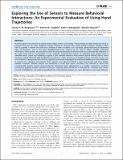Exploring the Use of Sensors to Measure Behavioral Interactions: An Experimental Evaluation of Using Hand Trajectories
Author(s)
Bergmann, Jeroen H. M.; Langdon, Patrick M.; Mayagoitia, Ruth E.; Howard, Newton
DownloadBergmann-2014-Exploring the Use of.pdf (2.215Mb)
PUBLISHER_CC
Publisher with Creative Commons License
Creative Commons Attribution
Terms of use
Metadata
Show full item recordAbstract
Humans appear to be sensitive to relative small changes in their surroundings. These changes are often initially perceived as irrelevant, but they can cause significant changes in behavior. However, how exactly people’s behavior changes is often hard to quantify. A reliable and valid tool is needed in order to address such a question, ideally measuring an important point of interaction, such as the hand. Wearable-body-sensor systems can be used to obtain valuable, behavioral information. These systems are particularly useful for assessing functional interactions that occur between the endpoints of the upper limbs and our surroundings. A new method is explored that consists of computing hand position using a wearable sensor system and validating it against a gold standard reference measurement (optical tracking device). Initial outcomes related well to the gold standard measurements (r = 0.81) showing an acceptable average root mean square error of 0.09 meters. Subsequently, the use of this approach was further investigated by measuring differences in motor behavior, in response to a changing environment. Three subjects were asked to perform a water pouring task with three slightly different containers. Wavelet analysis was introduced to assess how motor consistency was affected by these small environmental changes. Results showed that the behavioral motor adjustments to a variable environment could be assessed by applying wavelet coherence techniques. Applying these procedures in everyday life, combined with correct research methodologies, can assist in quantifying how environmental changes can cause alterations in our motor behavior.
Date issued
2014-02Department
Massachusetts Institute of Technology. Media Laboratory; Massachusetts Institute of Technology. Synthetic Intelligence LaboratoryJournal
PLoS ONE
Publisher
Public Library of Science
Citation
Bergmann, Jeroen H. M., Patrick M. Langdon, Ruth E. Mayagoitia, and Newton Howard. “Exploring the Use of Sensors to Measure Behavioral Interactions: An Experimental Evaluation of Using Hand Trajectories.” Edited by Derek Abbott. PLoS ONE 9, no. 2 (February 7, 2014): e88080.
Version: Final published version
ISSN
1932-6203